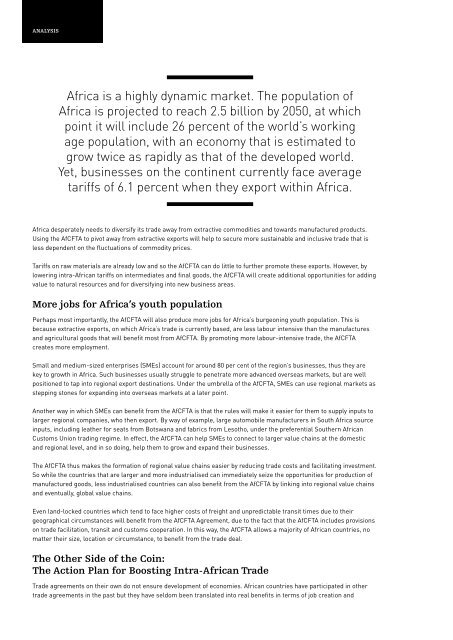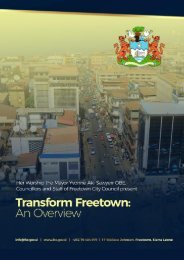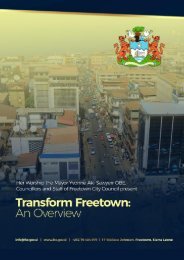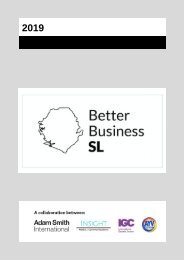Insight Magazine Issue 1 2018
Insight Magazine is Sierra Leone's most authoritative business and investment magazine. It is part of the stable of business and investment products and services which make up Insight Media and Communications (www.insight.sl). In this issue: We feature AYV’s Anthony Navo Junior – the man who is redefining the media landscape in Sierra Leone; Beatrice Chaytor, AUC trade advisor, brings her authoritative eye to the African Continental Free Trade Area; Fadi Bassir – our new contributor and expert in SSA investment discusses the benefits of equity finance; and Mariama Seray Barrie, agriculturist and writer, makes the case for an integrated approach to agricultural policy. The Mistake That Made Me – our new series dips into the wisdom of making mistakes; The Future is Female – a look at the changing landscape of African entrepreneurship; Did you make money during the elections? Most of you say no! Find more on www.insight.sl
Insight Magazine is Sierra Leone's most authoritative business and investment magazine. It is part of the stable of business and investment products and services which make up Insight Media and Communications (www.insight.sl).
In this issue:
We feature AYV’s Anthony Navo Junior – the man who is redefining the media landscape in Sierra Leone; Beatrice Chaytor, AUC trade advisor, brings her authoritative eye to the African Continental Free Trade Area; Fadi Bassir – our new contributor and expert in SSA investment discusses the benefits of equity finance; and Mariama Seray Barrie, agriculturist and writer, makes the case for an integrated approach to agricultural policy.
The Mistake That Made Me – our new series dips into the wisdom of making mistakes; The Future is Female – a look at the changing landscape of African entrepreneurship; Did you make money during the elections? Most of you say no!
Find more on www.insight.sl
You also want an ePaper? Increase the reach of your titles
YUMPU automatically turns print PDFs into web optimized ePapers that Google loves.
ANALYSIS<br />
Africa is a highly dynamic market. The population of<br />
Africa is projected to reach 2.5 billion by 2050, at which<br />
point it will include 26 percent of the world’s working<br />
age population, with an economy that is estimated to<br />
grow twice as rapidly as that of the developed world.<br />
Yet, businesses on the continent currently face average<br />
tariffs of 6.1 percent when they export within Africa.<br />
Africa desperately needs to diversify its trade away from extractive commodities and towards manufactured products.<br />
Using the AfCFTA to pivot away from extractive exports will help to secure more sustainable and inclusive trade that is<br />
less dependent on the fluctuations of commodity prices.<br />
economic growth. In order to make the most of the AfCFTA, African countries must effectively address supply side<br />
constraints and weak productive capacities, infrastructural bottlenecks, deficient trade information networks, poor<br />
access to finance for traders and other economic operators, and restrictions on movement of people. They must use<br />
measures such as trade facilitation and trade in services as important catalysts for market access.<br />
At the same time as they mandated the AfCFTA in 2012, the AU Assembly also launched the Action Plan for Boosting<br />
Intra-African Trade (BIAT), in a bid to deepen Africa’s market integration and significantly increase the volume of trade<br />
that African countries undertake among themselves. The BIAT Action Plan is organised into seven clusters as follows:<br />
(i)<br />
(ii)<br />
(iii)<br />
(iv)<br />
(v)<br />
(vi)<br />
Trade policy: to ensure implementation of coherent and efficient trade policies at all levels;<br />
Trade facilitation: to deal with all other non-tariff related trade constraints;<br />
Productive capacity: to improve low and inefficient means of production;<br />
Trade related Infrastructure: crucial for achieving trade competitiveness and diversification;<br />
Trade Finance: to improve access to finance for economic operators;<br />
Trade Information: crucial for making rational business decisions;<br />
(vii) Factor market integration: to increase intra-regional mobility of factors of production such as labour<br />
and capital.<br />
Tariffs on raw materials are already low and so the AfCFTA can do little to further promote these exports. However, by<br />
lowering intra-African tariffs on intermediates and final goods, the AfCFTA will create additional opportunities for adding<br />
value to natural resources and for diversifying into new business areas.<br />
More jobs for Africa’s youth population<br />
Perhaps most importantly, the AfCFTA will also produce more jobs for Africa’s burgeoning youth population. This is<br />
because extractive exports, on which Africa’s trade is currently based, are less labour intensive than the manufactures<br />
and agricultural goods that will benefit most from AfCFTA. By promoting more labour-intensive trade, the AfCFTA<br />
creates more employment.<br />
Small and medium-sized enterprises (SMEs) account for around 80 per cent of the region’s businesses, thus they are<br />
key to growth in Africa. Such businesses usually struggle to penetrate more advanced overseas markets, but are well<br />
positioned to tap into regional export destinations. Under the umbrella of the AfCFTA, SMEs can use regional markets as<br />
stepping stones for expanding into overseas markets at a later point.<br />
Another way in which SMEs can benefit from the AfCFTA is that the rules will make it easier for them to supply inputs to<br />
larger regional companies, who then export. By way of example, large automobile manufacturers in South Africa source<br />
inputs, including leather for seats from Botswana and fabrics from Lesotho, under the preferential Southern African<br />
Customs Union trading regime. In effect, the AfCFTA can help SMEs to connect to larger value chains at the domestic<br />
and regional level, and in so doing, help them to grow and expand their businesses.<br />
The AfCFTA thus makes the formation of regional value chains easier by reducing trade costs and facilitating investment.<br />
So while the countries that are larger and more industrialised can immediately seize the opportunities for production of<br />
manufactured goods, less industrialised countries can also benefit from the AfCFTA by linking into regional value chains<br />
and eventually, global value chains.<br />
Even land-locked countries which tend to face higher costs of freight and unpredictable transit times due to their<br />
geographical circumstances will benefit from the AfCFTA Agreement, due to the fact that the AfCFTA includes provisions<br />
on trade facilitation, transit and customs cooperation. In this way, the AfCFTA allows a majority of African countries, no<br />
matter their size, location or circumstance, to benefit from the trade deal.<br />
The Other Side of the Coin:<br />
The Action Plan for Boosting Intra-African Trade<br />
Trade agreements on their own do not ensure development of economies. African countries have participated in other<br />
trade agreements in the past but they have seldom been translated into real benefits in terms of job creation and<br />
Africa desperately needs to diversify its trade away from<br />
extractive commodities and towards manufactured<br />
products. Using the AfCFTA to pivot away from extractive<br />
exports will help to secure more sustainable and<br />
inclusive trade that is less dependent on the fluctuations<br />
of commodity prices.<br />
The BIAT Action Plan was developed to complement other existing initiatives also crucial in the boosting of intra-African<br />
trade such as the Action Plan for Accelerated Industrial Development of Africa (AIDA), the Programme for Infrastructure<br />
Development (PIDA) and the Comprehensive Africa Agriculture Development Program (CAADP), as well as the Protocol<br />
on Free Movement of Persons (which was also signed by several countries at the Kigali Summit). The challenge therefore<br />
for Africa lies in ensuring that there is smooth coordination and implementation of these initiatives as they liberalise<br />
goods and services under the AfCFTA.<br />
With the required political will for smooth implementation and the attendant flanking measures described under the<br />
BIAT Action Plan, the establishment of the AfCFTA will significantly accelerate growth of intra-African trade and allow<br />
Africa to use trade more effectively as an engine of growth and sustainable development. It will assist in the fight against<br />
poverty and underdevelopment in the continent and expand trade and investment opportunities for Africa. Again, the<br />
world is watching as Africa tries to chart its own development course - for a welcome change.<br />
Beatrice Chaytor is an international trade lawyer, specialising in providing advice and support to African governments<br />
in their engagement with regional and international trade policy processes. She is currently Senior Expert - Trade in<br />
Services in the Department of Trade and Industry at the African Union Commission, based in Addis Ababa, and works<br />
on the negotiations for the establishment of the African Continental Free Trade Area (AfCFTA). Prior to her position in<br />
the AUC, Ms Chaytor ran her own law firm, Chariot Eight in Freetown, Sierra Leone, providing legal services to local,<br />
regional and international clients on a range of corporate law matters including trade, investment, natural resources and<br />
environment.<br />
23<br />
www.insight.sl

















